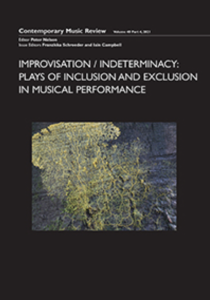Research outputs 2021
Distributed Perception: Resonances & Axiologies, London and New York: Routledge, 2021.
Edited, with an introduction and conclusion by Natasha Lushetich & Iain Campbell

Who, what, and where perceives, and how? What are the sedimentations, inscriptions, and axiologies of animal, human, and machinic perception/s? What are their perceptibilities? Deleuze uses the word ‘visibilities’ to indicate that visual perception isn’t just a physiological given but cues operations productive of new assemblages. Perceptibilities are, by analogy, spatio-temporal, geolocative, kinaesthetic, audio-visual, and haptic operations that are always already memory. In the case of strong inscriptions, they are also epigenetic events. In physics, resonance is the tendency of a system to vibrate with increasing amplitudes at certain frequencies of excitation. In cybernetics and in theories of technology, it refers to systems’ feedback. In Native science, resonance denotes the axiology of positions and events. It’s a form of multi-species perception that emphasises emergent directionality and protean mnemonics. This transdisciplinary volume brings together key theorists and practitioners from media theory, Native science, bio-media and sound art, philosophy, art his- tory, and design informatics to examine: a) the becoming-technique of animal– human–machinic perceptibilities; and b) micro-perceptions that lie beneath the threshold of known perceptions yet create energetic vibrations. The volume shows distributed perception to be a key notion in addressing the emergence and persistence of plant, animal, human, and machine relations.
For more information:
https://www.routledge.com/Distributed-Perception-Resonances-and-Axiologies/Lushetich-Campbell/p/book/9780367743017
Improvisation/Indeterminacy: Plays of Inclusion and Exclusion in Musical Performance, Contemporary Music Review, 2021, 40:4.
Edited with an introduction by Iain Campbell & Franziska Schroeder

Improvisation and indeterminacy seem to be aligned terms, both being associated with an acceptance of contingency and an openness to the unexpected. But how the terms of improvisation and indeterminacy have been deployed, and the musical practices they have been associated with, has not always borne this congruence out. Paralleling a theoretical scholarship that shows how notions of indeterminacy become entangled with mechanisms of power, the discourse of musical indeterminacy, and its co-articulation with improvisation, has played out in terms of how musical indeterminacy may itself produce new modes of exclusion along with its new modes of inclusion and freedom. The articles compiled in this special issue show improvisation and indeterminacy coupling and decoupling in diverse ways, exploring how indeterminacy can mark a zone of free play and an openness to change, or can operate hand in hand with control and the management of behaviour and difference.
For more information: https://www.tandfonline.com/toc/gcmr20/40/4
How Many Angels can Dance on the Head of a Pin? Understanding ‘Alien’ Thought
Natasha Lushetich, AI & Society, 27 July 2021: 1–15.
Initially coined by Weizenbaum in 1976, ‘alien’ thought refers to the radical difference with which ‘thinking machines’ approach the process of thinking. The contemporary paradox of over-determination and indeterminacy—caused largely by algorithmic decision-making in the civic realm—makes these differences both more entangled and more difficult to navigate. In this essay, I trace over-determination to Leibniz and Turing’s axiomatic procedures and to instrumental rationality, and I trace indeterminacy to the mid-twentieth century co-development of computers and neurosciences to advance the following proposition: understanding ‘alien’ thought requires understanding incomputability, temporal swarming, and inscriptive-significational errance.
Understanding these phenomena in turn requires understanding thinking by doing, distributed thinking, and ontological indeterminacy. All are present in machinic operations as well as in the twentieth century experimental artistic practices of artists such as Duchamp, Cage, and Xu, that rely on indeterminate procedures and function as diagrammatic machines. A diagrammatic machine is neither abstract nor particular; neither an idea that is determining in the supreme instance, nor an infrastructure that is determining in the last instance, but rather instantiates a real yet to come (Deleuze and Guattari 1987). In this essay, indeterminate artistic practices are used as an entry into ‘alien’ thought and its correlates—infinity and complexity—by way of aesthetic analogy.
For more information: https://link.springer.com/article/10.1007/s00146-021-01252-7